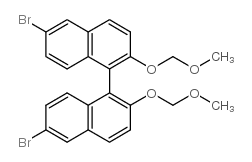179866-74-1
| Name | (R)-6,6'-Dibromo-2,2'-bis(methoxymethoxy)-1,1'-binaphthyl |
|---|---|
| Synonyms |
(R)-(+)-6,6'-DIBROMO-2,2'-BIS(METHOXYMETHOXY)-1,1'-BINAPHTHYL
(S)-6,6'-Dibromo-2,2'-bis(methoxymethoxy)-1,1'-binaphthalene |
| Density | 1.524 g/cm3 |
|---|---|
| Boiling Point | 553ºCat 760 mmHg |
| Melting Point | 129-133ºC(lit.) |
| Molecular Formula | C24H20Br2O4 |
| Molecular Weight | 532.22100 |
| Flash Point | 232.8ºC |
| Exact Mass | 529.97300 |
| PSA | 36.92000 |
| LogP | 7.15040 |
| Vapour Pressure | 0mmHg at 25°C |
| Index of Refraction | 1.655 |
|
Section 1: Product Identification Chemical Name:(R)-(+)-6,6'-Dibromo-2,2'-bis(methoxymethoxy)-1,1'-binaphthyl, min. 98% CAS Registry Number:179866-74-1 Formula:C24H20Br2O4 EINECS Number:none Chemical Family:organic alcohol Synonym:R-(+)-6,6'-Dibromo-2,2'-bis-methoxymethoxy-[1,1']binaphthalenyl
Section 2: Composition and Information on Ingredients IngredientCAS NumberPercentACGIH (TWA)OSHA (PEL) Title compound179866-74-1100%no datano data Section 3: Hazards Identification Emergency Overview:Irritating to eyes and skin. May be harmful if swallowed or inhaled. Primary Routes of Exposure:Ingestion Eye Contact:Causes mild irritation of the eyes. Skin Contact:Causes slight irritation of the skin. Inhalation:Inhalation of dust may lead to irritation of the respiratory tract. Ingestion:No information is available on the physiological effects of ingestion. May be harmful if swallowed. Acute Health Affects:Irritating to eyes and skin. May be harmful if swallowed or inhaled. Chronic Health Affects:No information available on long-term chronic effects. NTP:No IARC:No OSHA:No SECTION 4: First Aid Measures Immediately flush the eyes with copious amounts of water for at least 10-15 minutes. A victim may need Eye Exposure: assistance in keeping their eye lids open. Get immediate medical attention. Wash the affected area with water. Remove contaminated clothes if necessary. Seek medical assistance if Skin Exposure: irritation persists. Remove the victim to fresh air. Closely monitor the victim for signs of respiratory problems, such as difficulty in Inhalation: breathing, coughing, wheezing or pain. In such cases seek immediate medical assistance. Seek medical attention immediately. Keep the victim calm. Give the victim water (only if conscious). Induce Ingestion: vomiting only if directed by medical personnel. SECTION 5: Fire Fighting Measures Flash Point:no data Autoignition Temperature:no data Explosion Limits:no data Extinguishing Medium:dry chemical, carbon dioxide, water or foam. If this product is involved in a fire, fire fighters should be equipped with a NIOSH approved positive pressure Special Fire Fighting Procedures: self- contained breathing apparatus and full protective clothing. Hazardous Combustion andIf involved in a fire this material may emit irritating fumes of hydrogen bromide. Decomposion Products: Unusual Fire or Explosion Hazards: No unusual fire or explosion hazards. SECTION 6: Accidental Release Measures Small spills can be mixed with vermiculite, sodium carbonate or other suitable non combustible adsorbent and Spill and Leak Procedures: swept up. SECTION 7: Handling and Storage Handling and Storage:Store in a tightly sealed container. Keep away from heat and direct sunlight. SECTION 8: Exposure Controls and Personal Protection Eye Protection:Always wear approved safety glasses when handling a chemical substance in the laboratory. Skin Protection:Wear protective clothing and gloves. Consult with glove manufacturer to determine the proper type of glove. Ventilation:Material may form a fine dust. If possible, handle the material in an efficient fume hood. If in form of fine dust and ventilation is not available a respirator should be worn. The use of respirators Respirator: requires a Respirator Protection Program to be in compliance with 29 CFR 1910.134. Ventilation:Material may form a fine dust. If possible, handle the material in an efficient fume hood. Additional Protection:No additional protection required. SECTION 9: Physical and Chemical Properties Color and Form:white powder Molecular Weight:532.22 Melting Point:133° Boiling Point:no data Vapor Pressure:no data Specific Gravity:no data Odor:not determined Solubility in Water:slightly soluble SECTION 10: Stability and Reactivity Stability:air and moisture stable Hazardous Polymerization:no hazardous polymerization Conditions to Avoid:none Incompatibility:oxidizing agents Decomposition Products:carbon dioxide, carbon monoxide, organic fumes, and hydrogen bromide. SECTION 11: Toxicological Information RTECS Data:No information available in the RTECS files. Carcinogenic Effects:no data Mutagenic Effects:no data Tetratogenic Effects:no data SECTION 12: Ecological Information Ecological Information:No information available SECTION 13: Disposal Considerations Disposal:Dispose of according to local, state and federal regulations. SECTION 14: Transportation Shipping Name (CFR):Non-hazardous Hazard Class (CFR):NA Additional Hazard Class (CFR):NA Packaging Group (CFR):NA UN ID Number (CFR):NA Shipping Name (IATA):Non-hazardous Hazard Class (IATA):NA Additional Hazard Class (IATA):NA Packaging Group (IATA):NA UN ID Number (IATA):NA SECTION 15: Regulatory Information TSCA:Not listed in the TSCA inventory. SARA (Title 313):Title compound not listed. Second Ingredient:none SECTION 16 - ADDITIONAL INFORMATION N/A |
| Hazard Codes | Xi: Irritant; |
|---|---|
| Risk Phrases | R41 |
| Safety Phrases | 25-26-36/39 |
| HS Code | 2909309090 |
| HS Code | 2909309090 |
|---|---|
| Summary | 2909309090 other aromatic ethers and their halogenated, sulphonated, nitrated or nitrosated derivatives VAT:17.0% Tax rebate rate:9.0% Supervision conditions:none MFN tariff:5.5% General tariff:30.0% |

